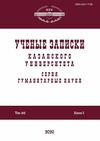О числительных с диффузной семантикой в китайском языке
On Numerals with Fuzzy Semantics in the Chinese Language
Author(s): Lyudmila Lvovna BankovaSubject(s): Language studies, Semantics
Published by: Казанский (Приволжский) федеральный университет
Keywords: Chinese language; Chinese numerals; semantic fuzziness; numerals with fuzzy semantics;
Summary/Abstract: This article considers the fuzzy (approximate, blurred) semantics of Chinese numerals. Despite their main function of expressing exact numbers, fuzziness is the innate feature of such numerals. Numerals with fuzzy semantics (or so-called imaginaries in the sense of structural linguistics) should not be confused with the approximate ones because they correlate fairly or in no way with actual numbers and bring to the fore the meanings of “much/many” or “little/few.” Here, the views of Russian and Chinese linguists on semantic fuzziness were summarized. The following three factors that determine it were described: transnational, nationally stipulated, and individually determined. Kang Su and Song Guangtian’s classifications of fuzzy numerals were analyzed and critically assessed. The functioning of fuzzy numerals in the Chinese language was discussed from a diachronic perspective. The analysis of the Chinese language history shows that the most common fuzzy numerals are three (meaning “many/much” or “few/little”), numerals denoting numbers that are a factor of three with the meaning of “many/much,” and place numerals such as ten, one hundred, one thousand, and ten thousand, also meaning “many/much.” In general, all numerals verbalizing the first ten numbers can have fuzzy semantics.
Journal: Ученые записки Казанского университета. Серия Гуманитарные науки
- Issue Year: 164/2022
- Issue No: 5
- Page Range: 97-109
- Page Count: 13
- Language: Russian

